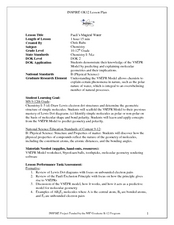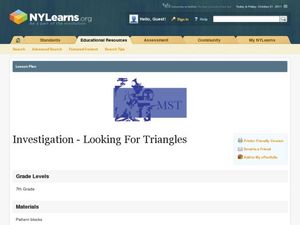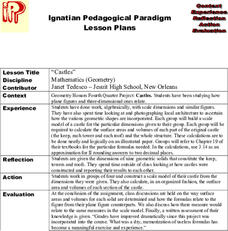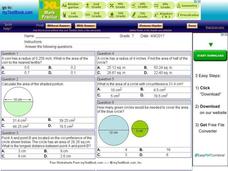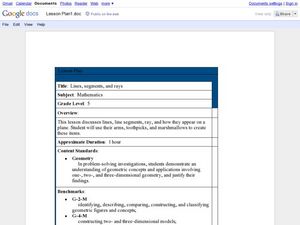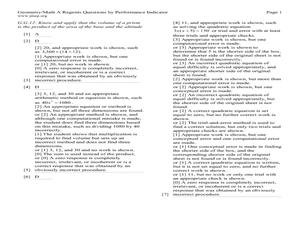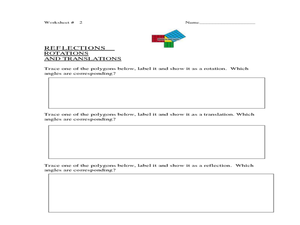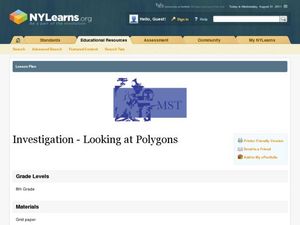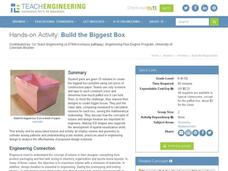Curated OER
Pauli's Magical Water
Students predict the shape of molecules using VSEPR theory. In this chemistry lesson plan, students differentiate a polar and nonpolar molecule. They discuss why water's polarity is very important.
Curated OER
Looking For Triangles
Students solve problems with triangles. In this geometry lesson, students analyze shapes to find different triangles. They name the shapes created by putting triangles together.
Curated OER
TAAS Attack Daily Upkeep 2 4th Grade
In this elementary math worksheet, 4th graders practice solving problems for reviewing the concepts of number sentences, numeration, and geometry.
Curated OER
Prime and Composite Numbers
Sixth graders inspect prime and composite numbers. Using graph paper, they draw as many different shaped rectangles as possible. They use the dimensions of the rectangles to discuss prime and composite numbers. Students create a chart...
Curated OER
Distortion Unleashed
Students view examples of man-made structures and create a building that matches the style. Using the internet, they research the style of Frank Lloyd Wright and create plans for creating their own community. They use a painting of...
Curated OER
Countdown Challenge: Triangle Inequality Theorem
In this triangle inequality instructional activity, students test the Triangle Inequality Theorem. They measure the sides of given triangles, identify the type of triangle, and name angles in the triangle. The one-page instructional...
Curated OER
Lines, Rays, Line Segments, and Planes
Students are introduced to lines, rays, line segments and planes and study the differences between them. They also practice graphing lines, rays, line segments and planes
Curated OER
Castles
Young scholars create a scale model to a castle using the dimensions they were given. They calculate the surface areas and volumes of each section of their castle.
Pennsylvania Department of Education
Tangram Challenges
Pupils explore geometric concepts by working with Tangram Puzzles. In this Tangram challenge instructional activity, students use problem-solving tasks that involve physical manipulatives. Pupils select a picture and use all...
Curated OER
What are the Kinds of Triangles?
Fifth graders classify triangles. In this triangle lesson, 5th graders learn about the characteristics that make up a triangle. They are instructed through video, PowerPoint slides, and teacher-led demonstrations.
Curated OER
Ten Multiple-Choice Circle Problems
In this circle worksheet, students solve ten multiple-choice questions concerned with the area, radius, diameter, and circumference of a circle. The solutions are provided by clicking on the "show answers" button on the bottom of...
Curated OER
Lines, Segments, and Rays
Fifth graders use their arm, toothpicks, and marshmallows to create lines, segments, and rays. In this lines, segments, and rays lesson plan, 5th graders learn how these appear on a plane.
Curated OER
Seven Volume of a Prism Problems
In this volume of a prism worksheet, young scholars calculate the volumes and missing lengths of seven prisms. The solutions are provided.
Curated OER
It's Not All Greek to Me
Learners find out the meaning for prefixes used in math vocabulary. By dissecting words used in everyday math, they figure out what the prefix indicates and what the word means. A variety of well-organized worksheets and activities...
Curated OER
Point Comparisons
Young geometers investigate two-dimensional figures using coordinate grids. They identify polygons and draw examples of their reflection, rotation, and translation on a coordinate grid. And they complete a worksheet practicing examples...
Curated OER
Organic Chemistry 231, Martin Larter, Exam 1
If you need a straightforward and comprehensive organic chemistry exam, check this one out. Chemistry pupils identify functional groups in molecule diagrams, draw a Lewis structure, fill in a table about molecular shape, predict boiling...
Virginia Department of Education
Molecular Model Building
During this hands-on activity, young chemists build molecular models based on the Lewis dot structure before studying valence shell electron pair repulsion theory.
National Institute of Open Schooling
Chemical Bonding
Name is Bond, covalent bond. Through readings and answering questions, classes explore the different types of chemical bonds, their characteristics, valence shell electron pair repulsion theory, and atomic orbitals.
NY Learns
Investigation - Looking at Polygons
Middle schoolers construct polygons by plotting points on a coordinate plane. Pupils connect the points and identify which polygons they have drawn. They will need graph paper to carry out the assigned activities. A vocabulary list,...
Curated OER
Teaching About Plate Tectonics and Faulting Using Foam Models
Young scientists learn about plate tectonics and the three different types of faults (normal, reverse, and strike-slip) using foam models. The activity also covers common types of locations where these faults are found.
Teach Engineering
Build the Biggest Box
Boxing takes on a whole new meaning! The second installment of the three-part series has groups create lidless boxes from construction paper that can hold the most rice. After testing out their constructions, they build a new box....
Curated OER
Building Homes
Students investigate architecture and construction by building a home from cardboard tubes. In this housing lesson, students collaborate in groups to plan and create buildings they can fit in made from cardboard tubes, newspaper...
Curated OER
Line Symmetry
Teach your class about symmetry lines with this resource. This instructional activity defines symmetry and explains lines of symmetry and how they work. Learners examine a variety of examples before drawing lines of symmetry in 5...
Curated OER
Tangrams
Students construct tangram pieces. Then they make observations and explore patterns with the pieces.


